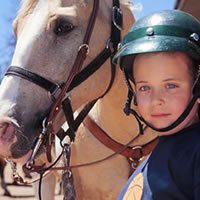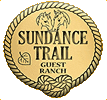
A Dude Ranch Beginner Rider’s Introduction to Horse Communication; Speaking to Your Horse (Part 1)
Horseback riding is a very big part of our lives here at Sundance Trail. We hope you find this little article useful!
Dude ranch horseback riding is a conversation. To get the most out of your riding experience, you need to talk with your horse, and you need to listen to your horse. This article is about talking to your horse.
It is not enough for you to want your horse to walk or whoa or turn left or turn right. You actually have to tell them! As silly as this sounds, many people never consider how to talk to a horse, they think, like Mr. Ed of TV, that horses speak English.
Dude ranch horses don’t speak English. Dude ranch horses speak Horse. There are different dialects of horse language, based on traditions (English, Western, Dressage, etc.) and geography. We have noticed that our guests from Great Britain speak a bit differently (and use different words) than those from Boston or Texas. It’s the same with horses.
We communicate our directions to the horse in four ways. We use voice, hands, feet, and balance.
The Dude Ranch Horse and Your Voice
First, when we want the horse to do something, we have to use words. We don’t use just any words, we need to use the words that the horse understands. Different horses are trained to use different verbal cues.
Around here, our horses understand: “Walk,” “Trot,” and “Whoa.” (Our next-door neighbor’s horses don’t understand the word “Trot” they say “Jog” over there.)
Most of our horses know their own names and will respond (or at least react) when called by name. Just like humans, horses have personalities, and boy do they have moods!
They are also taught the word “Quit!” when they are naughty.
Our horses do not understand the words: “Lets’ Go!” or “Come On!” or “Stop!”
Horses also respond to other verbal noises, we call these “cues.” Here we “click-click” with our tongues for “walk”, we use a series of short kissing sounds for jog/trot, and we use a long kissing sound for lope/canter.
Lastly, horses respond to our tone of voice. Hysterically screaming “Easy” to an anxious or frightened horse will not usually produce calmness!
The Dude Ranch Horse and Your Hands
Second, we follow our words with our hands. The bit (the metal bar in the horse’s mouth) or hackamore (around the horse’s nose) is meant to be a communication device. If used with a lot of strength or jerked suddenly, it can be a torture device. We teach folks to use a firm voice and soft hands.
How to hold the reins, how to move forward, how to turn (direct rein, neck rein), and how to slow down or whoa are done very differently in different traditions of riding) and within the Western tradition are done just a bit differently in different parts of the country, and even vary from ranch to ranch.
It is way beyond the scope of this article to teach you how to use your hands. At this stage, just know that the reins are not for balance (the horse’s mouth and nose are very sensitive!); remember to use a firm voice and soft hands, and ask your wrangler to teach and demonstrate.
The Dude Ranch Horse and Your Feet
Third, we communicate with our feet. We use our feet to move the horse forward and to steer.
To ask the horse to walk, we say “Walk” or click-click with our tongue and add a squeeze with our ankles. This “squeezes the horse forward.” If we want a quick giddyap, we tap or actually kick the horse with our ankles. Don’t start with a kick if a squeeze will do, but don’t be afraid to move from squeezing to tapping to kicking if the horse is ignoring you.
Beginner riders should never wear spurs!
Steering also involves the feet. We have taught our horses to move away from pressure. If we want the horse to move to the left, we will “push” with our right foot. If we want him or her to move to the right, we will “push” with the left foot.
When we want the horse to slow down or to stop, we push our feet out forward, to act as shock absorbers. That way we don’t go “over the handle-bars.”
The Dude Ranch Horse and Your Balance
Finally, our balance can communicate to the horse what we want them to do. Leaning forward generally means to speed up. Looking and turning our head and shoulders in the direction that we want to go will turn the horse. And leaning back (sitting back on our pockets) will tell him or her we want to slow down. Some teachers will tell you: “The horse will go where you are looking.”
Putting It All Together
So, bottom line. You can’t be passive. The horse cannot read your mind. You must speak his/her language (Horse) in words and motions that he/she can understand. You can learn these by asking the wranglers
Oh, and be a bit patient. Horses are not the quickest or the brightest of animals. It will take a few minutes for your horse to understand your “accent.”
Wow! This all sounds so complicated! It’s not really. It just takes a bit of practice and a bit of coaching.
Here at the Sundance Trail, you will find that the wranglers follow set of “learning steps” in their care and feeding of their dude riders. (You educators call this a curriculum – but we don’t want to use words like “curriculum” when we’re being cowboys!) Your wrangler will start you with a “class” on ground manners, then communication, then practice in the arena, and so on. As you feel comfortable, and demonstrate skill in an arena and trails, your wrangler will add new skills to learn. You will nver be bored, and you will never be overwhelmed.
If you are new to a stable, ask the wranglers to give you a demonstration of how they communicate. Learn their particular dialect of Horse.
Most wranglers at most ranches are happy to teach and coach you, but you do have to ask. Wranglers are generally very non-intrusive persons, and will stay quiet until you ask.
If you are ready, let’s move on to Part 2, or back to the list of articles.
